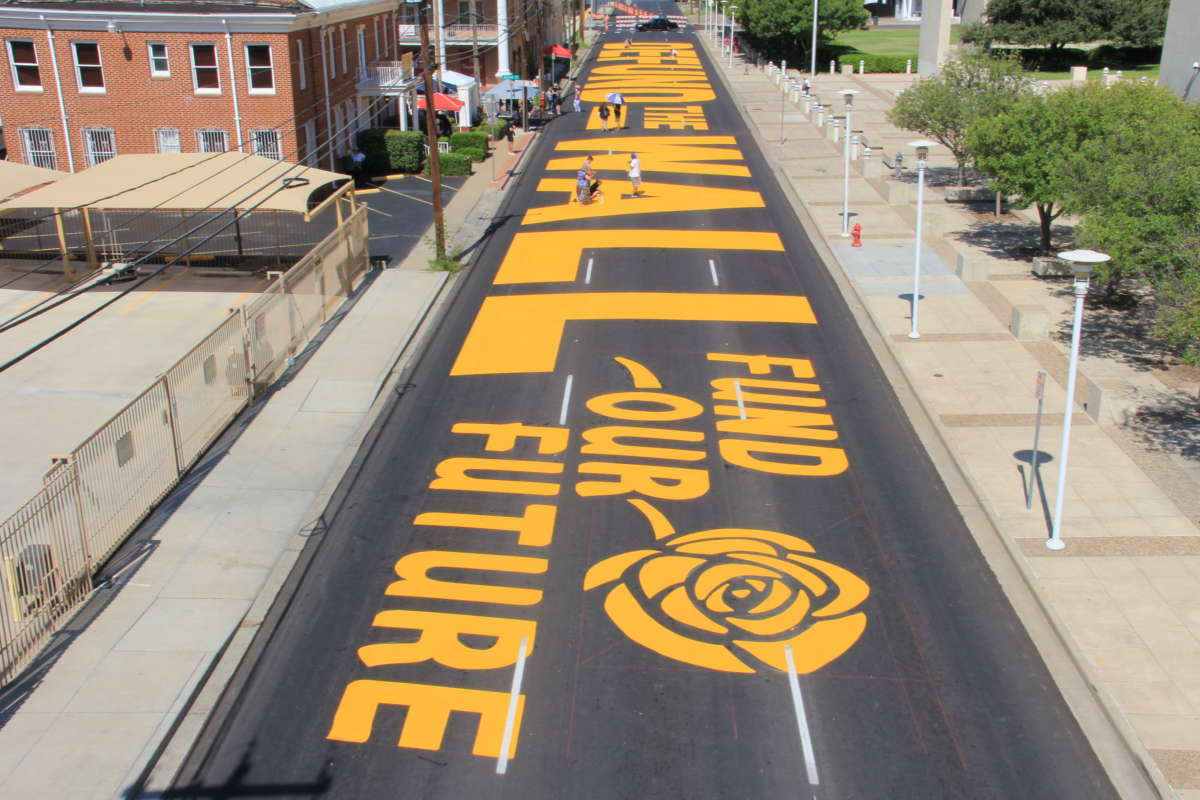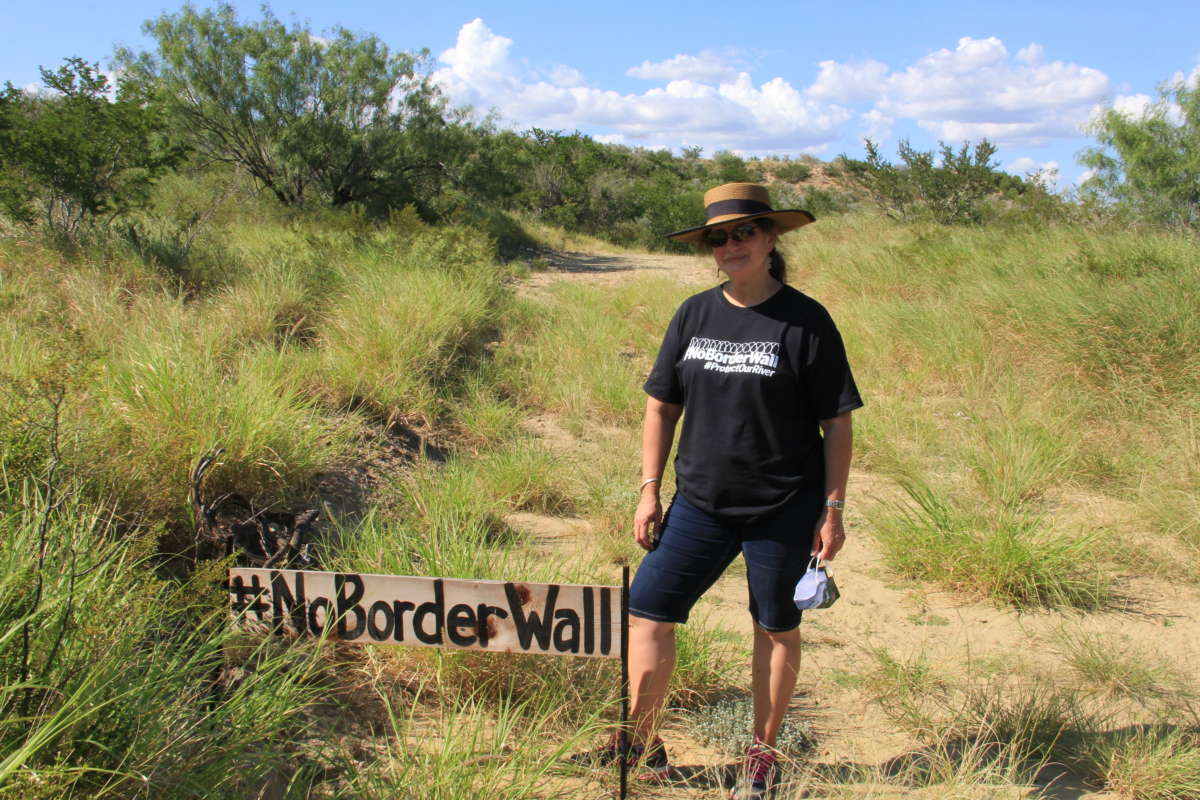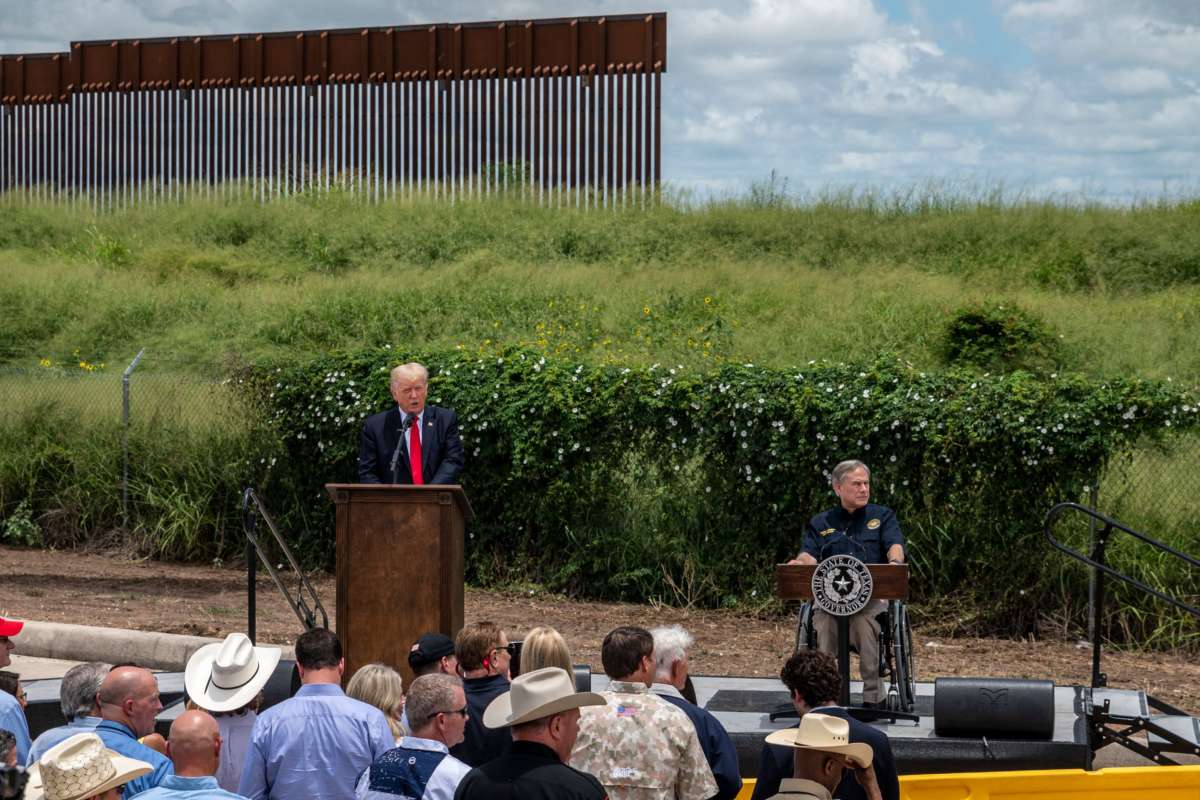Border communities pushed back against false narratives asserted by former President Donald Trump and Texas Gov. Greg Abbott during their tour Wednesday of parts of the U.S.-Mexico border where Governor Abbott has vowed to fulfill Trump’s campaign promise to complete a border wall.
Trump and Abbott held a briefing with state and law enforcement officials at the Weslaco Department of Public Safety headquarters before heading to Pharr, Texas, just across the river from Reynosa, Mexico, where 19 people were killed during cartel-related shootings two weeks ago. Against a segment of unfinished wall, Trump and Abbott amplified GOP narratives of chaos at the border amid a complex increase in apprehensions due in part to Trump administration policies.
According to U.S. Customs and Border Protection, there were 180,034 apprehensions last month at the southern U.S. border, with almost 40 percent of those who were turned back having previously crossed, according to the Dallas Morning News. During the Trump administration, the highest recorded number of monthly apprehensions was nearly 150,000.
But, as Truthout has previously reported, “the increase in crossings is happening in part because 70,000 asylum seekers were already in line, stuck in Mexico after being forced to wait there under Trump’s restrictive Migrant Protection Protocols.” The situation, immigrant rights advocates point out, is not quite a “surge,” but “a regular seasonal influx of asylum-seeking children bolstered by a backlog of demand because of last year’s COVID-19 border closure.”
During Republicans’ border trip Wednesday, Abbott criticized Vice President Kamala Harris for visiting El Paso instead of the Rio Grande Valley, where apprehensions are more acute. President Joe Biden has tasked Harris with targeting poverty, violence and other root causes of migration in Guatemala, Honduras and El Salvador. But while Biden has ended Trump’s “Remain in Mexico” policy, he has kept in place Title 42 of the public health code, allowing officials to use the pandemic to justify denying asylum seekers’ entry.
La Unión del Pueblo Entero (LUPE), which advocates for border communities, held a rally in San Juan, Texas, to push back against the GOP’s spin and pressure Democrats to lift remaining Trump administration restrictions hours before Trump and Abbott arrived. The rally featured progressive favorite Jessica Cisneros, who lost her primary bid against Rep. Henry Cuellar last year, and Texas Democratic Party Chairman Gilberto Hinojosa.
“It’s unconscionable that the governor is wasting attention and resources to stir hate rather than focus on the urgent issues, such as fixing the state’s power grid.”
“It’s unconscionable that the governor is wasting attention and resources to stir hate rather than focus on the urgent issues, such as fixing the state’s power grid,” said LUPE Executive Director Juanita Valdez-Cox. Democratic Party Chairman Hinojosa similarly characterized Abbott’s wall scheme as a political distraction from the statewide power grid failure in February that took more than 700 lives and more recent loss of more than 12,000 megawatts of power, saying Abbott is “busy promoting Trump’s pet project” and using border residents as “props for his political theater.”
In March, Abbott announced that he would deploy more state police and National Guard troops to the border under Operation Lone Star. Two months later, he issued a disaster declaration in 34 Texas counties amid the ongoing influx of border apprehensions. Facing challenges from the right as he seeks a third term, including a potential challenge from former Texas GOP Chair Allen West, Abbott announced two weeks ago that Texas will continue Trump’s border wall project, starting with $250 million shifted from the state prison budget.
This week, Abbott amended his disaster declaration to remove several border counties that refused to partner with the state, including the four largest counties in the Rio Grande Valley. The remaining declarations, however, allow Abbott to request the emergency transfer of legislative funds to begin construction of the border wall. Legal experts and some lawmakers, however, have questioned the legality of Abbott’s disaster declaration, arguing migration issues are reserved under the federal government’s jurisdiction.
As the Texas Tribune reports, the governor has said he expects the state will receive “hundreds of miles” to build the border wall on state-owned lands and privately donated land. In addition to the $250 million from the Texas Department of Criminal Justice, the state has also received at least $459,000 in private donations through a crowdfunding website.
“While $250 million is a drop in the bucket as far as the costs of this illogical infrastructure project, it is a shitload of money that could be put to good use for things that a state should be funding.”
But with estimates ranging from $26 million to $46 million to build a mile of wall in some areas of South Texas, border activists are renewing their demands to “defund the wall,” saying the $250 million being shifted from the state prison budget should instead be used to address real crises on the border: addressing the health, education, ecological and economic disparities that Tejano people face every day.
As Truthout has previously reported, the No Border Wall Laredo Coalition has long linked its demands for these kinds of investments to the larger movement for Black lives and to defund police, both in court and on the street, demonstrating the connection between the systemic, carceral racism of Trump’s, now Abbott’s, border wall (which activists call a “prison wall”) and the systemic racism of U.S. policing.
Coalition activists say Abbott’s issuing of a disaster declaration over increased border apprehensions rings hollow to communities that, only a year ago, were under similar declarations after suffering the highest per capita rates of death amid the pandemic and more losses during the February blackout. Last year, Governor Abbott’s office dispersed critical aid from the federal CARES Act “at a lower rate than the federal government, leaving some of the hardest-hit border cities, like Laredo, holding the bag.” Those communities are still in need of deep investments to recover from COVID-19’s devastation, Coalition members say.
Now, Texas Democrats are trying to keep Abbott from siphoning off $15 billion in COVID relief funds for the wall, signing a letter this week urging Treasury Secretary Janet Yellen to block him from doing so. They are also asking the Treasury to fashion rules that would ensure the money “can’t be used to replenish state funding for border barriers,” according to San-Antiono Express News.

“On the one hand, while [$250 million] is a drop in the bucket as far as the costs of this illogical infrastructure project, it is a shitload of money that could be put to good use for things that a state should be funding,” says Coalition member Tricia Cortez, who is also the executive director of the nonprofit Rio Grande International Study Center, which works to preserve and restore the Rio Grande Basin.
Just a fraction of the money being reallocated to Abbott’s wall scheme, she says, could vastly improve living standards in underserved areas in the borderlands that face immense inequality, such as informal settlements like the colonias that lack basic necessities, often including potable water, septic or sewer systems, electricity, paved roads, or safe and sanitary housing.
Cortez says Abbott’s dropping of major Rio Grande Valley counties from his disaster order shows his border wall scheme is more of a political stunt than a serious danger. “We view this as a sideshow, and we don’t feel as threatened by it in the sense of condemnation and construction here on our lands,” she tells Truthout. “I think that we don’t have that same level of apprehension with this, but at the same time, we’re also going to be working on different fronts.”
Pressuring local leaders is one of those fronts. The Coalition worked with Laredo City Council members, who unanimously voted in favor of sending a letter to Abbott opposing his state-funded border wall, and recently passed a resolution affirming that position this week. Laredo is the seat of Webb County, which was among the counties that balked at being included in Abbott’s emergency declarations at the border.
“We view this as a sideshow, and we don’t feel as threatened by it in the sense of condemnation and construction here on our lands.”
Mercurio Martinez III, a Laredo city council member whose family has owned land along the river for generations, told Truthout that he would like to see a portion of the $250 million go instead to expand and improve a 50-mile unpaved stretch of road to Eagle Pass.
If Abbott attempts to seize land in Laredo through eminent domain to complete the border wall, “He’s going to have to fight us through the courts,” Martinez says — just like the Trump administration did. “From what I can see of him removing Webb County from the emergency declaratory, to me it’s very political, those counties along the river that voted for Biden and not for Trump got off the list.”
Trump ultimately built 450 miles of wall during his presidency. While the Biden administration halted construction and returned $2 billion that Trump tapped from the Pentagon budget, Truthout previously reported that his administration has failed to dismiss hundreds of Trump-era eminent domain cases as officials continue to review federal resources used to build the wall.
Melissa Cigarroa, board president of the International Study Center, is one of the many Mexican American plaintiffs whose Trump-era land condemnation case is being left in legal limbo under the Biden administration. Every month, she says, her case gets delayed.
“The cities that have the greatest focus on migration issues are the ones who are opting out of Abbott’s plan. What does that tell you? That it addresses nothing.”
Border area families like hers face imminent decisions of whether to accept the federal government’s land compensation offers or continue expensive legal fights in the hopes that the Biden administration may drop their cases.
Cigarroa’s 175-acre ranch along the Rio Grande River is in Zapata County, which remains included under Abbott’s disaster declaration despite being part of an ongoing court challenge against Trump-era border wall land seizures and to the Department of Homeland Security’s waivers of at least 27 federal laws in order to expedite wall construction.
Many of the counties that are choosing to partner with the state, like Zapata, Cigarroa says, are doing so because they hope to receive additional funding streams that would support border enforcement and security measures.

“This is such a boneheaded approach to fake dealing with a fake crisis. It’s just a manufactured political ploy by a very weak governor who feels like he’s intimidated from other right-wing candidates,” Cigarroa says. “The cities that have the greatest focus on migration issues are the ones who are opting out of Abbott’s plan. What does that tell you? That it addresses nothing.”
With so little money for what is needed to finish Trump’s wall, Cigarroa likewise doesn’t see Abbott’s state funding scheme as much of a threat as the federal government apparatus under Trump, and in some ways continuing under Biden, is in terms of land seizures.
“Basically, [Abbott’s] proposing funneling dollars to private ranchers to help them fix their fences, and then he’s going to count that as a win,” she tells Truthout. “Private ranchers have the roads degrade every time there’s a huge storm — they’re ranch roads, they’re dirt roads — so road maintenance and fence maintenance is a thing that ranchers do all the time.”
“Basically, Abbott’s proposing funneling dollars to private ranchers to help them fix their fences, and then he’s going to count that as a win.”
Private funding schemes have not panned out in the past. In 2018, the founders of We Build the Wall, Brian Kolfage and former White House strategist Steve Bannon, crowdfunded more than $25 million to build a three-mile section of border wall in the Rio Grande Valley. They were later indicted on wire fraud and money-laundering conspiracy charges for using hundreds of thousands of dollars from the fund for personal expenses. Amid increased erosion, the campaign’s border barrier segment is now at risk of falling into the river.
“It’s really offensive because the state invests so little in us, and where they want to infuse a shitload of state money, it’s going to be instead on something so destructive and ineffective, all for one guy’s political ambitions,” the International Study Center’s Cortez says.
Our most important fundraising appeal of the year
December is the most critical time of year for Truthout, because our nonprofit news is funded almost entirely by individual donations from readers like you. So before you navigate away, we ask that you take just a second to support Truthout with a tax-deductible donation.
This year is a little different. We are up against a far-reaching, wide-scale attack on press freedom coming from the Trump administration. 2025 was a year of frightening censorship, news industry corporate consolidation, and worsening financial conditions for progressive nonprofits across the board.
We can only resist Trump’s agenda by cultivating a strong base of support. The right-wing mediasphere is funded comfortably by billionaire owners and venture capitalist philanthropists. At Truthout, we have you.
We’ve set an ambitious target for our year-end campaign — a goal of $250,000 to keep up our fight against authoritarianism in 2026. Please take a meaningful action in this fight: make a one-time or monthly donation to Truthout before December 31. If you have the means, please dig deep.
